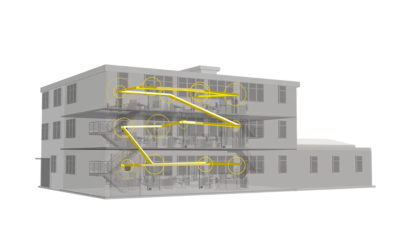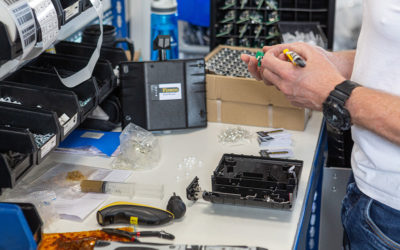Jump to:
Introduction
The benefits of dynamic emergency exit signage over conventional, passive ‘running man’ are proven and well established. It reduces risk, increases the safety factor and helps you, your staff and visitors feel that much safer providing a little extra peace of mind to all concerned.
| 1. See | You see it more than twice as easily |
| 2. Decide | Helps you make up your mind over twice as quickly. |
| 3. Move | Gets you moving towards safety in less than half the time. |
| 4. Exit | Keeps you moving by cutting congestion at exits by over a third. |
In summary, it is much better at getting your people out safely in an emergency, whatever this might be. Modern life has brought us different types of emergency to consider beyond that of fire meaning we need to be flexible and agile in keeping our people safe. This includes how we direct them around or out of the building under different conditions such as a terrorist attack, a bomb or chemical alert, or even active shooter.
You would imagine therefore that everyone would want it in their building wouldn’t you? After all, why wouldn’t you want to increase the safety of your people for as little as a few £000’s? Unfortunately, life is not that simple. There are other factors to consider both for and against dynamic signage implementation. These include things such as compliance and cost.
Firstly, we know compliance is a legal requirement and that many organisations feel this to be adequate even though they also know it is a minimum standard.
Strictly speaking of course, they are right; it should be adequate. However, is adequate enough, particularly when it comes to safety?
When it comes to cost, clearly, change invariably costs, in the short-term at least. For an organisation working in a small space and/or where money is tight clearly the cost versus benefit argument may seem less conclusive.
Not all of us have the luxury of being able to consider upgrading any aspect of our working environment, even our fire system, when the budget does not allow or when the return on investment is less apparent and more difficult to justify.
However, there is a number of other issues and needs that dynamic signage could help you address. There are also circumstances where it could actually save you money as well as make your life easier that many fail to consider.
So, let us explore these four key motivators and reasons for specifying dynamic signage over the conventional equivalent that you may not have considered and that may enable you to justify upgrading to a performance-based solution even if you had previously dismissed the idea:
- Structural problem
- Operational need
- Aspirational want
- Moral imperative/Personal desire
A building’s structure, size, shape and layout impact how it is used and how it can be used.
Older buildings provide greater individualism, interest and character and can be great places to work. Furthermore, they may have historical and architectural significance, provide balance as well as diversity to a cityscape and preserving them helps save the look of the built environment as well as natural resources. However, they can be complicated and costly to run, change, update or re-purpose.
More modern buildings typically offer greater efficiency, flexibility and cost-effective than older ones together with being more readily adapted to suit our changing needs.
However, both older and newer buildings bring their own challenges things can change in both. Owners change, tenants move, organisations grow or shrink, and areas may be re-purposed each of which can bring the need for structural changes.
With older buildings in particular, balancing occupancy capacity with the structural restrictions such as narrow corridors or tighter stairwells may create the need for complex remodelling or a more complex fire strategy. Less open space and less clarity in terms of evacuation routes add to the challenge as does the risk of fewer practicable escape routes and the potential delay in decision making when trying to exit the building due to less linear corridors and more options within a floor or space risking lack of compliance.
A re-modelling project may have inadvertently confused one or more exit routes increasing exit complexity and a lack of clarity restricting sign-off by Building Control.
Providing clear, intuitive guidance to a broader, international demographic with differing levels of familiarity of the space and fitness in such circumstances can also be difficult with simple, passive signage.
As responsible people, we need to ensure we have an effective fire strategy in place and that we can ensure the safety and security of all building occupants in such circumstances and in a range of emergency situations.
Dynamic signage can help resolve issues that such changes may create, typically much more quickly and cost-effectively than the alternative re-design, re-model or structural change.
Furthermore, Building Control is beginning to recognise that dynamic signage offers greater flexibility and control over conventional signage such that they may even suggest it as an alternative to a structural change.
Operational need
The growing complexity and design of modern buildings brings new challenges to address when trying to ensure an efficient evacuation. It is often necessary to employ new approaches in terms of controlling people movement and fire strategies are becoming more advanced and elaborate accordingly.
Such approaches include phasing the evacuation by floor or zone or directing the occupants in different directions based upon given scenarios. It may be appropriate to evacuate a single floor or group of floors perhaps moving them upwards and downwards to the adjacent, safe floors rather than directing them out of the building.
Given it is not just about a fire, strategies and infrastructure need to be sufficiently flexible to adapt and enable agile solutions that can help manage the movement of people in almost any emergency situation. Those of us responsible for managing large, complex buildings in such a variety of dangerous circumstances need all the help we can get, and dynamic signage can help.
Dynamic signage not only provides clarity and efficiency it also enhances your ability to manage people movement and adapt at short notice and in accordance with the emergency or crisis you might be faced with. Control that is simply not possible with conventional signage.
Each sign is addressable meaning it can be controlled independently of those around it and its behaviour (ie passive, dynamic green arrow and adaptive red cross), can be dictated by not only the fire panel through cause-and-effect programming but it is also possible to manually intervene if necessary.
This enables you to consider, anticipate and predict a range of scenarios and then pre-determine the corresponding reaction of the signage. Should x and y happen then the signs 1-6 will do this. However, should z happen too then signs 2 and 3 will do this instead.
Similarly, it enables to you to adapt as the environment changes. It also enables the controlled evacuation of different areas or floors of the building to be directed in different directions spreading the loading across the available facilities.
The facility for manual intervention adds an additional level of control to allow for the unanticipated or indeed a current and temporary variable such as an area of the building being closed for refurbishment or being used for an alternative purpose such as event or meeting.
The added performance and functionality over that provided by more traditional signage brings your building in the 21st Century making it properly SMART being able to cope with the modern living and working environments whilst bringing the flexibility and agility to adapt to short-term and long-term changes and plan for the future knowing you are keeping your people safe as they can be throughout.
Aspirational want
Aspirational may be defined as the want to achieve or the desire to perform to a high level, not being satisfied with the status quo. Where would modern manufacturing or the aviation industry be without the continuous improvement aspiration? This is very much performance beyond compliance and may be a personal and an organisational imperative.
These days, the values that an organisation or brand live by or stand for make a difference to how they perform. This also impacts how they are perceived by the outside world so their staff, suppliers, customers and even competitors. This might include the culture within the organisation and how staff are treated, who they work with, how they operate, why they do what they do and what’s important to them.
Perhaps you just want to be the best, the biggest, the fastest, the most profitable, the best to work for or have the nicest working environment. Why shouldn’t this include the safest too?
Increasingly, health and safety is becoming a more dominant priority. Anyone who is familiar with the construction industry will know how it has been transformed by proactively prioritising health and safety from site procedures to how staff and visitors park their cars.
Offices and buildings are simply other kinds of ‘site’ and we should consider the health and safety within them just as much as a Project Manager might consider it on their construction site. Keeping our people safe is, after all, the first thing any employer must do.
Dynamic signage is at the heart of this want. An alarm sounds then the number one priority is to ensure that everyone on site can exit quickly, safely and calmly something that dynamic signage was designed to help enable.
Surely our people and hence our buildings should be as safe as they can be, and this is something that should become integral to our personal and organisational missions and aspirations.
We always consider ways to save costs don’t we? Perhaps it is time we also consider ways to save lives.
Moral imperative/Personal desire
Wikipedia defines a moral imperative as ‘A strongly felt principle that compels that person to act’.
We want those people who use our buildings to be safe. We also expect the buildings we use and inhabit to be safe.
The HSE defines the first responsibility or duty of an Employer is ‘to protect the health, safety and welfare of their employees and other people who might be affected by their business. Employers must do whatever is reasonably practicable to achieve this.
This means making sure that workers and visitors are protected from anything that may cause harm, effectively controlling any risks to injury or health that could arise in the workplace’.
The Government defines the first responsibility of a landlord is to ‘keep the property you live in safe and free from health hazards’.
So as business owners, employers, and landlords we have a moral imperative to keep people in our employ, under our care and in our buildings safe.
Shouldn’t we therefore do everything we can to ensure this? In modern society is simple compliance, or adherence to the minimum requirement enough? We are rarely satisfied with the minimum of anything so why should we be when it comes to fire safety? Furthermore, when we realise the inefficiencies of system that is based upon signage developed in the 1970’s, isn’t it time we all felt obliged to fit the latest and best solution to help minimise risk and keep our buildings and our people safe?
Can we really go home to sleep soundly with peace of mind having achieved or maintained the minimum safety levels in our buildings? Is this the way a truly responsible person should feel? If we know dynamic signage is basically twice as effective than the conventional running man, perhaps we have the moral imperative to do something about and buy or specify it today.
Summary
If you recognise and appreciate the benefits of dynamic signage over the conventional passive type but are concerned about cost or feel compliance to be adequate, please remember that apart from helping to save lives, there are many ways in which it can help make your life easier from reducing risk to increasing control and enabling change. There are also many circumstances where it can save your money through enabling a complex structural solution to pass formal scrutiny without significant
and costly change.
Make the time and find out more today.
Alan Ward
07715 404213
alan.ward@evaclite.com
www.evaclite.com






